
Are you tired of tossing and turning at night? Or maybe you’re waking up with nagging neck pain that just won’t go away? The way you position your pillow while sleeping could be the culprit. Yep, that’s right—your pillow’s position can make or break your sleep quality. In this guide, we’ll explore the proper pillow position for sleeping so you can enjoy restful nights and wake up feeling refreshed.
Why Pillow Positioning Is So Important
You might not give it much thought, but the way your pillow is positioned plays a crucial role in your sleep health. A properly positioned pillow supports the natural curve of your spine, keeps your neck in alignment, and helps prevent discomfort. If you don’t position your pillow properly, you might experience issues like neck pain, headaches, or even back problems. But with the right positioning, your pillow can help you achieve deeper, more restorative sleep.
How to Choose the Right Pillow for Optimal Positioning
Before we dive into the proper pillow position for sleeping, let’s talk about selecting the right pillow. Because no matter how well you position it, the wrong pillow won’t give you the support you need.
- Sleep Position: Your sleep position is the first thing to consider. Side sleepers typically need a firmer, higher pillow to fill the space between their head and the mattress. Back sleepers benefit from a medium-thickness pillow that supports the neck without pushing the head too far forward. Stomach sleepers often need a very thin pillow—or none at all—to keep the spine in a neutral position.
- Pillow Filling: The fill inside your pillow plays a huge role in comfort and support. Memory foam pillows mold to your head and neck, offering personalized support, while down or feather pillows provide a soft, cushioned feel. If you’re looking for something a bit different, consider buckwheat pillows—they’re filled with natural buckwheat hulls, which allow for excellent airflow and customizable firmness.
- Pillow Loft: Loft refers to the height or thickness of your pillow, which is crucial for maintaining proper head and neck alignment with your spine. The right loft keeps your head in a neutral position, avoiding strain. If you’re unsure about the ideal loft for your needs, consider an adjustable pillow with a zippered opening. These pillows allow you to add or remove fill, customizing the loft to suit your comfort and sleeping position perfectly.
Proper Pillow Position for Different Sleeping Styles
Now that you’ve got the right pillow, let’s get into the best way to position it based on your preferred sleeping style.
1. For Back Sleepers:

- Pillow Positioning: If you sleep on your back, place your pillow so that it supports the natural curve of your neck. Your head should rest comfortably in the center of the pillow, without tilting too far forward or backward. This position helps keep your spine aligned.
- Additional Support: To further reduce strain on your lower back, consider placing a small pillow or rolled towel under your knees.
2. For Side Sleepers:
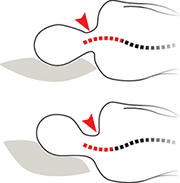
- Pillow Positioning: Side sleepers need a pillow that fills the space between their ear and the mattress, keeping the head and neck in a straight line with the spine. The pillow should be thick enough to maintain this alignment, but not so thick that it causes your head to tilt.
- Arm Placement: Keep your arms parallel to your body or hug a pillow to avoid shoulder strain. If you’re prone to shoulder pain, placing a pillow between your knees can also help maintain proper alignment.
3. For Stomach Sleepers:
- Pillow Positioning: Stomach sleepers should use a very thin pillow or none at all to prevent excessive arching of the neck. By minimizing the height under your head, you help keep your spine in a more neutral position.
- Additional Support: Consider placing a pillow under your pelvis to maintain a natural curve in your lower back, reducing strain on your spine.
Fluff, Squish, and Shape: Achieving the Proper Pillow Position for Sleeping
When it comes to getting that perfect pillow shape, malleable pillow filling like down or buckwheat work well. Moldable pillow fillings like these allow you to fluff, squish, and shape your pillow exactly how you like, giving you just the right support where you need it. You can easily adjust these pillows on the fly. On the other hand, memory foam pillows don’t offer the same flexibility. They’re firm and hold their shape, which can be great for consistent support but doesn’t allow for much customization. So, if you’re someone who likes to mold your pillow into the perfect nest, down or buckwheat might be the way to go!
Common Mistakes to Avoid with Pillow Positioning
It’s easy to position your pillow incorrectly. Avoid these common mistakes:
- Pillow Too High or Too Low: The height of your pillow (loft) is crucial. A pillow that’s too high can push your neck upwards, while one that’s too low can cause your neck to sink. Both scenarios can lead to discomfort and a restless night.
- Ignoring the Lifespan of Your Pillow: Over time, most pillows lose their shape and support, which can negatively impact your sleep quality. Traditional pillows need to be replaced more frequently, but if you’re using a buckwheat pillow, you’re in luck—they tend to last much longer, maintaining their support and comfort for years with proper care. If your pillow feels flat or unsupportive, it’s probably time to consider a replacement.
- Incompatible Mattress and Pillow Combo: Your mattress and pillow should work together to support your body. A mattress that’s too soft or too firm can throw off your alignment, even if your pillow is positioned correctly.
The Bottom Line on Pillow Positioning
Achieving the proper pillow position for sleeping can significantly enhance your sleep quality and overall well-being. By keeping your spine aligned and providing the right support, you can wake up feeling refreshed and free from discomfort. So, take a moment to assess your pillow and sleep habits, make any necessary adjustments, and get ready for some sweet, restful sleep!
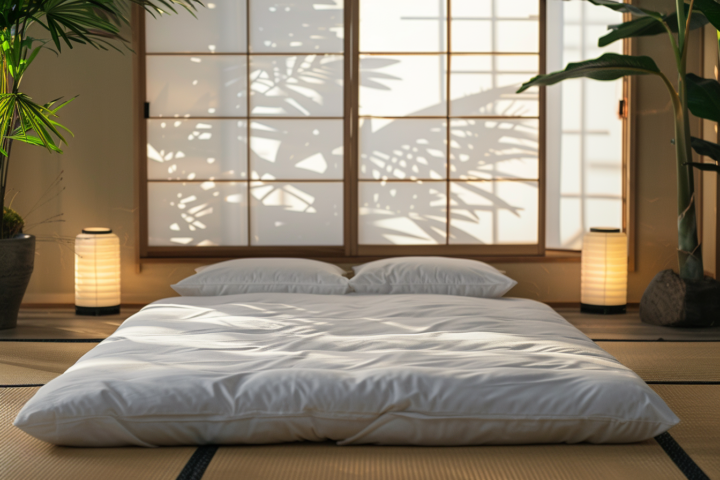
There is a striking cultural divide between East and West where sleeping habits are concerned. We in the West are accustomed to beds raised on frames topped with soft, thick mattresses. Conversely, the Japanese tradition embraces a more grounded approach to sleep, literally, with firm mattresses placed directly on the floor.
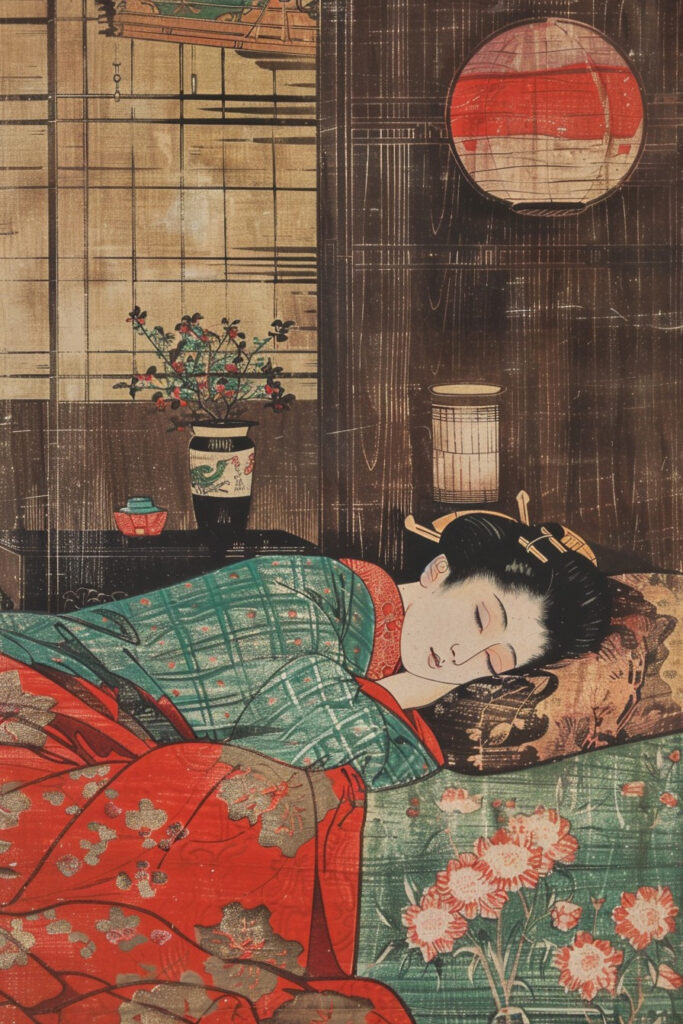
Futon: Traditional Japanese Bed Benefits
A traditional Japanese bed is commonly referred to as a futon. Futons are firm mattresses designed to be laid on the floor and are paired with:
- sobakawa or buckwheat pillows for neck and head support, and
- tatami mats that give another layer of support and promote airflow (preventing mold). They’re sort of like carpets.
1. Versatile and Economical Comfort
Their use dates back to the 17th century, when Japanese homes needed to be versatile. With space at a premium, rooms served various purposes by day and night, necessitating furniture that was as easy to stow away as it was functional. The futon, lightweight and easily moved, emerged as an elegant solution to these space challenges. It was also affordable, making it a popular choice across social strata.
2. Cool Rest
The science is pretty simple: warm air rises. Thus sleeping on the floor will help to keep you comfortably cool all night long as the warm air in your bedroom rises to the ceiling.
3. Enhanced Sleep Posture (Supposedly)
A soft mattress may cause your spine to misalign, potentially resulting in back pain and other problems. It’s true. Many modern mattresses can be excessively soft, causing them to dip in the center. This lack of support for the lower back forces it to bear our weight all night.
Conversely, a firm surface, such as a futon on the floor, supports your spine in a neutral alignment, contributing to better posture overall (and theoretically less discomfort)
Despite the benefits of sleeping on the floor some studies show that a mattress that is too firm can cause discomfort! So which is it? Is sleeping on the floor good for you or not?
Comfort is subjective.
Some people sleep best on softer surfaces while others prefer firmer ones. Most sleep experts agree that mattress firmness is a personal choice. There is no right mattress for everyone. Thus most manufacturers produce a variety of mattresses with varying firmness.
In exploring the history of Japanese sleep hygiene, we can see how our cultural backdrop shapes our perception of comfort. The stark differences in mattress design between eastern and western cultures illustrates that the way we sleep is deeply influenced by the conventions and traditions of society.
So, why do Japanese people sleep on the floor? It’s all about blending tradition, practicality and comfort.
The use of futons on tatami mats isn’t just a nod to cultural heritage; it’s a smart, space-saving choice that can be surprisingly comfy. Plus, it’s a great way to keep things simple and minimalist in the bedroom. This sleeping style, deeply rooted in Japanese culture, offers a unique approach to rest that contrasts with the plush beds we’re accustomed to.
Good night!
Or in Japanese, おやすみ (Oyasumi)
Learn More About Japanese Comfort Traditions…
In addition to sleeping on the floor, it’s common in Japan for people to sit on the floor for meals, tea ceremonies, and other activities. A popular seating option is the floor pillow. These floor pillows are frequently filled with buckwheat hulls, providing firm, comfortable support that molds to the body’s shape. The use of buckwheat pillows for both sleeping and sitting is rooted in their ability to promote comfort and natural posture, making them a versatile and ergonomic option.

Scientific evidence suggests that regular sauna use can improve sleep by increasing deep sleep cycles, boosting melatonin production, and decreasing stress levels.
I built a sauna in my basement last year and almost immediately noticed that I slept better and longer when I started taking a sauna before bed. I wasn’t aware this was considered one of the benefits of sauna use, but the improvement was obvious to me. Most of us recognize the importance of a good night’s sleep for our health and well-being, so I looked into the science of taking a sauna before bed and its affect on sleep. Sure enough, scentific research reveals a relationship between heat exposure and better sleep. There are a few specific mechanisms at work when understanding how saunas improve sleep.
Sauna Significantly Increases Deep Sleep
Scientific studies indicate that regular sauna bathing can positively impact sleep patterns. Sleep is understood to have three different stages, identified through brain-wave patterns, eye movements, and muscle activity. Non-rapid eye movement (NREM) stage 3 sleep, better known as “deep sleep” or slow-wave sleep is an essential stage for restorative sleep. This stage is believed to be important for physical restoration and cognitive function. Research indicates that heat therapy such as regular sauna use is associated with an increase in deep sleep stages, highlighting its potential as a valuable sleep aid.
Sauna Can Increase Melatonin
Sauna use has been associated with an increase in melatonin production. Melatonin is a hormone produced by the pineal gland in the brain, and it plays a crucial role in regulating the sleep-wake cycle. Several studies have explored the impact of sauna bathing on melatonin levels, suggesting a potential link between sauna use and the modulation of this sleep-regulating hormone.
The body’s circadian rhythms play a vital role in regulating sleep-wake cycles. Sauna use has been linked to the modulation of circadian rhythms, influencing the release of melatonin. A study in Chronobiology International (Leppäluoto et al., 2005), titled “Endocrine effects of repeated sauna bathing,” investigated the hormonal changes induced by sauna bathing. The study observed increased melatonin production following sauna sessions, suggesting a potential mechanism by which saunas contribute to improved sleep onset and maintenance.
Stress Reduction from Sauna Use Before Bed
We all experience stress in day-to-day life. Luckily, the sauna experience is synonymous with relaxation, and its impact on stress reduction is well-documented. Stress and anxiety are significant contributors to sleep disturbances. A study published in the Journal of Applied Physiology (Hannuksela & Ellahham, 2001) highlighted the role of sauna bathing in reducing cortisol levels, the hormone associated with stress. By promoting a state of relaxation, saunas can alleviate stress and, consequently, improve sleep quality.
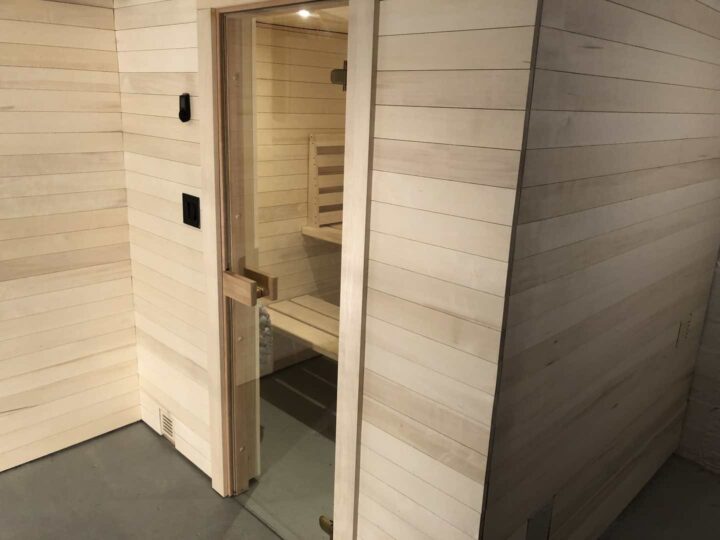
Temperature Regulation and Sleep
Sauna use involves exposing the body to high temperatures followed by a cooling-off period. This process not only induces overall relaxation, but also contributes to a drop in core body temperature. The subsequent cooling phase aligns with the natural decline in temperature that occurs before sleep, potentially promoting better sleep quality.
Do you have to sauna before bed to get sleep benefits?
Studies I read simply research “regular” sauna bathing or heat therapy – measured as some combination of temperature, duration and frequency. It appears that health benefits are especially related to frequency, so more frequent use seems to increase the benefits. It’s not necessary to sauna immediately before bedtime to reap the benefits. In fact, most recommendations are to sauna at least 1-3 hours prior to bedtime to allow your body to completely cool down after heat exposure. I typically sauna in the late afternoon, hours before going to sleep. The key is to use the sauna regularly, at whatever time of day works best for you. While there are no guarantees that using the sauna will cure your insomnia, my personal experience is that my sleep has genuinely improved since making the sauna part of my regular routine.
Sources
- https://pubmed.ncbi.nlm.nih.gov/2578367/
- https://www.ncbi.nlm.nih.gov/pmc/articles/PMC6015540/
- https://pubmed.ncbi.nlm.nih.gov/3788622/
- https://pubmed.ncbi.nlm.nih.gov/11165553/
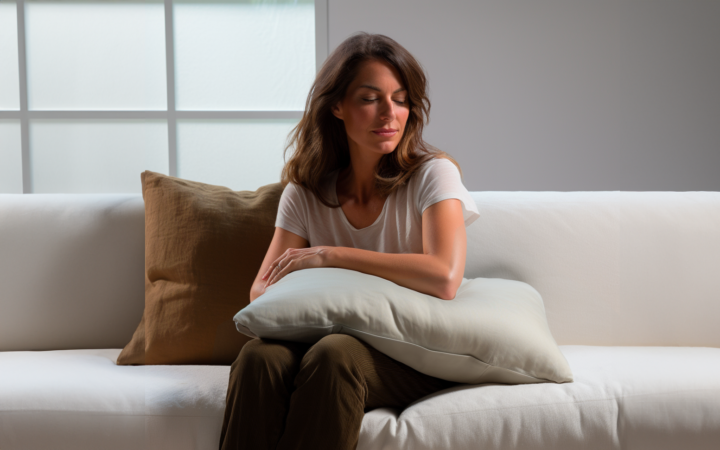
Hugging a weighted pillow is like experiencing a gentle, enveloping embrace. The uniform pressure creates an instant sense of calm and coziness. It’s like a reassuring pat on the back, telling you, “You’re doing great, and everything’s going to be just fine.”
– Luna Dreamweaver, Blissville, CA
The above description might sound a little silly, but it’s surprisingly accurate. Weighted pillows have an uncanny knack for making you feel snug and secure. They may not literally understand your feelings, but the evenly distributed pressure of a weighted pillow does provide a genuine sense of relaxation and tranquility. People love them for a reason, after all!
This feeling is a manifestation of the well-documented principle of Deep Pressure Stimulation (DPS), which has been proven to reduce stress, alleviate anxiety, and enhance overall well-being.
You’ve probably already heard about weighted blankets. Growing awareness of the benefits of DPS and its positive effects on mental health and well-being have made them a very popular story in the media. As these blankets have become more widely available, they’ve garnered a dedicated following. The surge in interest reflects a growing awareness of the importance of self-care and the pursuit of a more balanced and peaceful life, turning weighted blankets into a soothing symbol of modern well-being.
Like their blanket counterparts, weighted pillows apply uniform weight and pressure to the body. Drawing from DPS research and user feedback, these pillows have been found to provide the same comfort and relief that weighted blankets do.
The Magic of Deep Pressure Stimulation (DPS)
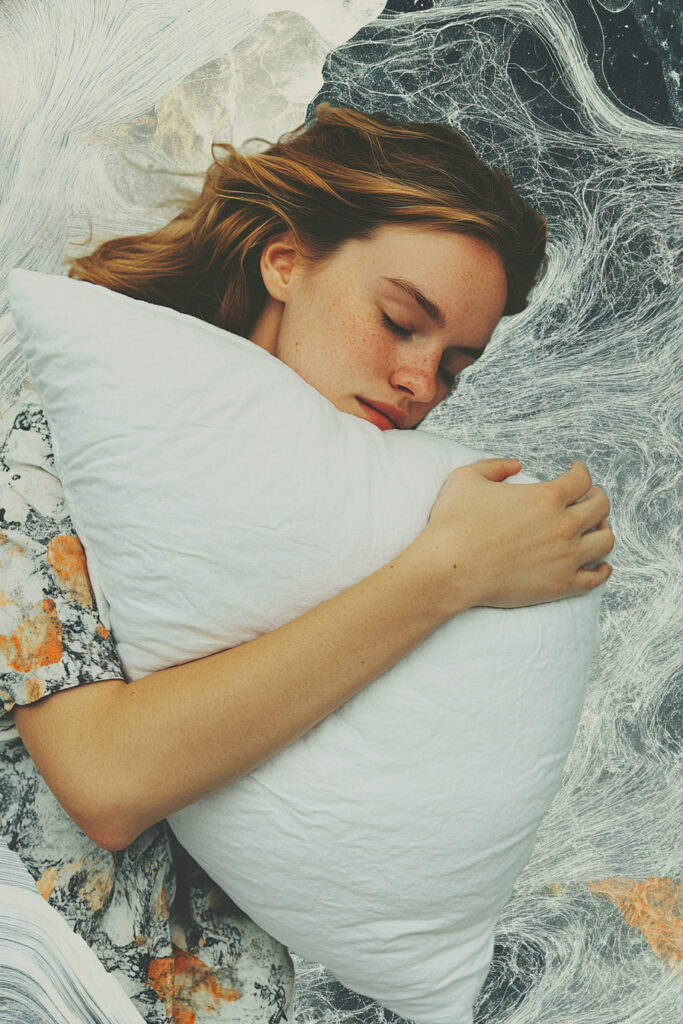
Evidence shows that Deep Pressure Stimulation (DPS) offers a myriad of benefits. Apparently it’s the concept of “even pressure” that unlocks its therapeutic potential. Consistent pressure, whether from a weighted blanket, vest, or pillow, activates the body’s parasympathetic nervous system, signaling it to relax and reduce stress. MAGIC!
Weighted pillows can offer a wide range of benefits, including:
- Stress Reduction: DPS has a calming effect on the nervous system, reducing the production of stress hormones like cortisol, and promoting relaxation.
- Improved Sleep: Many people find that DPS helps them fall asleep faster and enjoy deeper, more restful sleep by reducing restlessness and nighttime awakenings.
- Anxiety Relief: The soothing pressure from DPS can alleviate symptoms of anxiety, promoting a sense of security and tranquility.
- Mood Enhancement: DPS is associated with increased serotonin and dopamine production, which can lead to improved mood and a sense of well-being.
- Sensory Regulation: DPS is beneficial for individuals with sensory processing disorders, such as autism or ADHD, as it can help modulate sensory input and reduce sensory overload.
- Pain Relief: DPS can alleviate discomfort and pain in conditions such as fibromyalgia, arthritis, and muscle tension by promoting relaxation and reducing muscle tension.
- Focus and Attention: Some individuals, particularly those with ADHD, find that DPS can improve focus and concentration.
- Emotional Regulation: DPS can help individuals manage and regulate their emotions by promoting a sense of calm and emotional stability.
Innovative Uses of Weighted Pillows
Weighted pillows are being creatively used in various therapeutic settings. Occupational therapists often incorporate weighted pillows into sensory rooms and therapy sessions to help individuals with autism or sensory processing disorders achieve calm and focus. Additionally, some people use weighted pillows as a meditation aid, placing them on their lap or shoulders to create a grounding effect that enhances mindfulness practices. These versatile pillows can also serve as ergonomic supports during work or travel. They can alleviate tension in the lower back or neck when used as a cushion for chairs or car seats. As interest in weighted products continues to grow, these innovative applications highlight the adaptability and potential benefits of weighted pillows.
What are My Weighted Pillow Options?
Most weighted pillows are filled with materials like:
- glass beads,
- plastic pellets,
- buckwheat hulls, or
- other dense pillow filling types.
The filling in these pillows is notably heftier than the types used in traditional bed pillows.
How to Choose the Right Weighted Pillow:
- Materials: Pay attention to the materials used in the pillow’s cover. It should be durable and breathable. Weighted pillows are considerably heavier than traditional pillows and thus require a more durable cover. We recommend breathable organic cotton and double-stitched seams!
- Cover Type: Check if the pillow’s cover is removable and machine washable. This feature can make maintenance and hygiene more convenient. A zippered opening that allows the filling to be removed before a wash is a must for most weighted pillows.
- Weight: Weighted pillows come in various weight options, typically ranging from a few pounds to over 10 pounds.
- Size: Weighted pillows are available in different dimensions. Consider the size of the pillow in relation to your bed and your own body size for the best fit.
What weighted pillow do we recommend? A buckwheat pillow of course!
A buckwheat pillow’s unique hull filling makes it an excellent choice as a weighted pillow. The natural weight of buckwheat hulls provides a gentle and evenly distributed pressure. Additionally, buckwheat hull filling is a superior alternative to petrochemical-produced pillow filling like plastic beads for several reasons:
- All-Natural: Buckwheat hulls are a natural, plant-based material, free from potentially dangerous synthetic chemicals.
- Breathability: Buckwheat hulls allow for better air circulation, helping regulate temperature and preventing the buildup of heat and moisture, which can be a concern with some synthetic fillings.
- Eco-Friendly: Choosing buckwheat hulls promotes sustainability as it reduces reliance on non-renewable petrochemical resources. Buckwheat is a 100% Compostable and renewable resource.
- Durability: Buckwheat hulls are known for their long-lasting nature, reducing the need for frequent pillow replacements. Mother earth and your wallet will both approve.
Buckwheat pillows provide a safe and environmentally friendly option for those seeking all the benefits of a weighted pillow. A buckwheat pillow will provide a soothing and calming sleep experience, reducing stress and promoting a restful night’s sleep while prioritizing safety and sustainability.
What size and weight should I get?
When choosing a weighted pillow, opt for a weight/dimension that offers comfortable pressure relative to your body size. It should feel comforting, not restrictive; you should be able to easily reposition your pillow. Thus for children aged 3-12, a smaller pillow weighing 3-6 pounds is generally suitable, while adults will likely benefit from a larger pillow around 10 pounds. Some will prefer a weighted body pillow, which can weigh 14 pounds or more (these things can pretty hefty and are best for use in your bed).
- Children & Adults 14×20″ and 4 lb.
- Adults 20×26″ and 10 lb.
- Adults (for use in bed) 20×36″ and 14 lb.
Alternatively, you can make your own. It’s an easy way to save yourself some money and a fun project for your next rainy weekend: How to Make a Weighted Pillow

Choosing the Right Pillow: Your Buckwheat Pillow Buying Guide
Choosing the right pillow is essential for ensuring you get the restful sleep you need. Buckwheat pillows have become increasingly popular in recent years. As a result, a ton of companies have sprung up to sell them. The many different options are overwhelming. In this buckwheat pillow buying guide, we will take a closer look at buckwheat pillows and why our product, Hullo, is the best choice on the market.
Understanding Buckwheat Pillows
Buckwheat pillows are filled with, you guessed it, buckwheat hulls, the outer protective shells of buckwheat seeds. Buckwheat hulls’ unique shape makes it excellent pillow filling. The individual hulls’ rough edges grip one another, enabling your pillow to conform perfectly to the shape of your head and neck, eliminating any uncomfortable pressure points. Traditional pillows can lose their shape and support over time, while buckwheat pillows offer consistent and comfortable support all night long.
Buckwheat hull filling is also breathable. They allow air to circulate through your pillow, keeping you cool throughout the night.
Finding the Perfect Buckwheat Pillow
1. Assessing the Quality of Components
- Fabric case — Opt for a breathable and durable organic cotton fabric that keeps your pillow comfortably cool while preventing rips and tears. Buckwheat hulls are not light (about 10 lb. for a standard size pillow), so your pillow’s seams should be double-stitched. A ripped seam can make quite a mess! Hullo utilizes a 7 oz/yard organic cotton twill fabric, striking the ideal balance between comfort and durability.
- Zipper — a high-quality zipper will keep your pillow’s buckwheat hulls where they belong — inside your pillow. Individual buckwheat hulls are quite small and can get past a cheap non-locking zipper or one that is improperly stitched.
- Buckwheat Hulls — The right hulls for use in a pillow are not easy to find. They should be vacuum-cleaned, intact (not crushed), and of adequate size to ensure breathability. With every purchase of buckwheat hulls from our suppliers, we painstakingly inspect all sources and purchase only the very best available.
Our commitment to quality ensures that your Hullo pillow will last for years, providing excellent support and comfort every night.
2. Emphasizing Sustainability
Sustainability plays a pivotal role in selecting a buckwheat pillow. At Hullo, we prioritize eco-friendly practices throughout our production and shipping processes.
- Renewable and Compostable Materials — Our buckwheat pillows are crafted using renewable, compostable, and organic materials, minimizing their environmental impact compared to traditional pillows that end up in landfills for hundreds of years.
- Durability and Replaceable Filling — Hullo pillows are designed to last, with easily-replaceable filling thanks to its zippered opening. By offering a long-lasting product, we reduce resource consumption and contribute to a more sustainable future.
- Environmentally-Friendly Production and Transportation — From fabric cases to buckwheat hulls and cardboard boxes, Hullo prioritizes locally sourced materials, significantly reducing energy waste and pollution generated during transportation.
3. Additional Benefits: Fast, Free Shipping, and 60-Day Return Window
Hullo ships free via UPS Ground to the 48 Contiguous United States. Every Order. Every Day.
We want you to be completely satisfied with your Hullo pillow, and we stand behind our product with a generous return policy. Try Hullo for 60 nights. If you’re not happy with the sleep you’re getting with Hullo, just ship it back to us and we’ll refund the purchase price.
In conclusion, when it comes to choosing a buckwheat pillow, Hullo is the clear choice. Our commitment to quality, sustainability, and customer satisfaction ensures that you will get a pillow that provides excellent support, lasts for years, and minimizes your environmental impact. Choose Hullo for the best night’s sleep you’ve ever had.

Neck pain can be a real nuisance, and it’s no surprise that people are always looking for ways to alleviate the discomfort. While there are many different types of pillows on the market, buckwheat pillows have become increasingly popular among those seeking relief from neck pain. Let’s explore the benefits of buckwheat pillows and whether or not they are good for neck pain.
What are Buckwheat Pillows?
Buckwheat pillows are filled with buckwheat hulls. Commonly used in Japanese cuisine, buckwheat is a type of grain. People clean and process the outer shells of the buckwheat grain, the hulls, to create a filling for pillows. Buckwheat pillows are a superior alternative to traditional pillows due to the unique qualities of their hull filling.
Benefits of Buckwheat Pillows
Buckwheat pillows have several benefits that make them a popular choice for those with neck pain. First and foremost, the pillows are adjustable. You can adjust the height and firmness of the pillow to suit your needs by moving the buckwheat hulls around inside the pillow. This means that you can create a custom pillow that provides the support you need to alleviate neck pain.
Another benefit of buckwheat pillows is that they are breathable. The hulls allow air to flow through the pillow, which can help keep you cool and comfortable while you sleep. This is especially important if you tend to get hot at night, as traditional pillows can trap heat and make you feel uncomfortable.
Most importantly, buckwheat hulls are malleable. Buckwheat hull filling will conform perfectly to the shape of your head and neck eliminating uncomfortable pressure points, cradling your head consistently all night long.
Will Buckwheat Pillows Help Relieve Neck Pain?
In short, yes, buckwheat pillows can be good for neck pain. They’re adjustable, provide the support you need, and buckwheat hull fill will keep you comfortably cool while you sleep.
It’s worth noting that buckwheat pillows may not be suitable for everyone. Some people find the pillows to be too firm, while others find them too noisy (the hulls can rustle when you move around on the pillow). However, many people have found relief by using buckwheat pillows, so it’s worth giving them a try if you’re looking for a new pillow.
Conclusion
If you suffer from neck pain, a buckwheat pillow may be a good choice for you. These pillows are adjustable, breathable, and above all, comfortable, making them a popular alternative to traditional pillows. While they may not be suitable for everyone, many people have found relief from neck pain by using buckwheat pillows. Consider trying one out to see if it works for you!
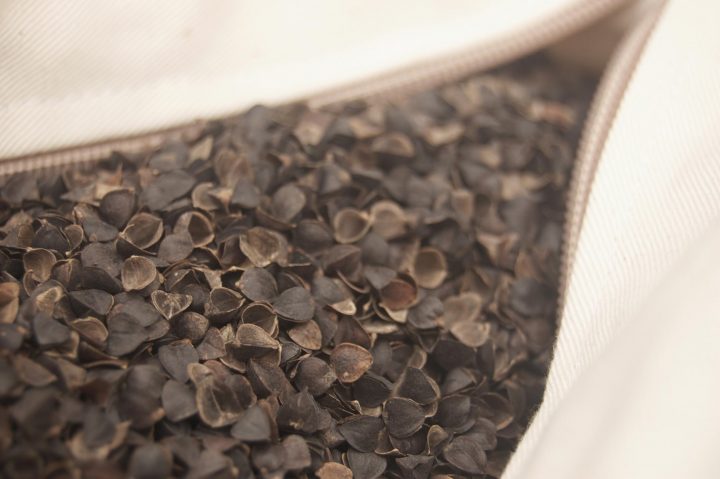
Buckwheat pillows have been gaining popularity in recent years, with many people turning to them as an alternative to traditional down or foam pillows. But are buckwheat pillows comfortable? Let’s explore the features and benefits of buckwheat pillows and help you decide if they’re the right for you…
Firstly, what are buckwheat pillows? Buckwheat pillows are filled with the husks of the buckwheat plant, which are small, triangular-shaped seeds. These seeds are known for their durability, and they don’t compress like traditional pillow fillings. This means that buckwheat pillows can provide better support for your head and neck.
Buckwheat pillow highlights include
- Customizable Support: Buckwheat pillows allow users to adjust the filling to their desired level of firmness and support, providing a personalized sleeping experience.
- Improved Sleep Posture: The natural contours of buckwheat hulls allow for proper spinal alignment and reduced pressure points, resulting in a more comfortable and restful sleep.
- Breathable: Buckwheat hulls allow for air circulation, keeping the pillow cool and dry throughout the night. This can be especially beneficial for people who tend to get hot while sleeping.
- Sustainable and Eco-Friendly: Buckwheat is a renewable resource and its use in pillows reduces waste and supports environmentally responsible practices.
So, are buckwheat pillows comfortable?
The answer largely depends on your personal preference. While some people swear by the support and adjustability of buckwheat pillows, others find them too firm or noisy. The sound of the hulls moving around in the pillow can be a dealbreaker for some.
If you’re considering a buckwheat pillow, it’s important to give it a try before making a purchase. Look for a retailer that offers a trial period, or try a friend’s pillow to get a feel for the texture and support. Keep in mind that it may take some time to adjust to a buckwheat pillow if you’re used to traditional down or foam options.
In conclusion, buckwheat pillows have many benefits that can make them a comfortable option for some people. Their adjustability, breathability, and support make them a great choice for people who struggle with traditional pillow options. However, it’s important to try a buckwheat pillow before making a purchase, as the texture and sound may not be right for everyone.

Hullo™ is obviously comfortable, but it has another benefit: it is a sustainable product. That is, it’s produced in a way that minimizes its impact on the environment and society.
When we started Hullo over 10 years ago, we knew we needed to do it responsibly:
- We make our buckwheat pillows with renewable, compostable, and organic materials. Hullo will not lie in a landfill for hundreds of years like pillows made with petrochemicals.
- Hullo pillows are designed to be durable and include easily-replaceable filling. A long-lasting product reduces resource consumption.
- Hullo is produced and transported using environmentally-friendly methods. The fabric cases, buckwheat hulls and cardboard boxes are produced locally, substantially reducing wasted energy and the pollution generated in transporting goods.
Additionally, we contribute 1% of all our profits to The Nature Conservancy, a nonprofit organization that is dedicated to protecting nature and preserving biodiversity around the world. Many eco-charities do good work, but The Nature Conservancy has proven very effective among its peers.
The Nature Conservancy works to:
- protect critical habitats: The organization protects important habitats for plants and animals, including forests, wetlands, and oceans. By conserving these areas, The Nature Conservancy ensures that these ecosystems continue to function properly and provide valuable services to humans and other species.
- Address climate change: The Nature Conservancy is committed to finding solutions to the climate crisis, which is one of the biggest threats to biodiversity and the health of our planet. They work to promote renewable energy, reduce carbon emissions, and promote sustainable land use practices.
- preserve endangered species: The Nature Conservancy protects endangered species by preserving their habitats, reducing threats from invasive species, and working with local communities to promote conservation.
- promote sustainable agriculture: The organization works with farmers and ranchers to promote sustainable agricultural practices. This helps protect soil health, water quality, and biodiversity.
- support scientific research: They conduct scientific research which helps us better understand the natural world. This research then informs effective conservation strategies.
Please consider making a donation to The Nature Conservancy. You and/or your business can support these important conservation efforts and protect the planet for future generations!

Flying is rarely a comfortable experience, even when you’re sitting in first class seats.
Packaged shoulder-to-shoulder in a tight little cylinder with germ (and virus) spewing strangers is a difficult endeavor, especially when it’s a long flight. Ever tried to sleep on an airplane? I see people sleeping soundly while in flight and it makes me very envious. How do they do it? I’m tall and it seems I’m incapable of sleeping upright. For that reason, plane travel is especially difficult for me. I can’t stretch out my legs, and there’s no place to rest my head.
Sitting comfortably is difficult. Sleep is impossible. Flying sucks.
While passing through an airport recently, I took notice of the many ridiculous looking neck pillows wrapped around traveller’s necks.
They can quickly transform a fashionable traveller into a frumpy neck-injury patient. Despite that, these odd pillows are quite popular. It seems that every store in the airport has a goofy version of the travel pillow.
I was intrigued. Would an airplane pillow help me get comfortable on the plane?
Consider what your bed pillow does for you every night at home… It cradles your head and neck. It fills the space between your head and your mattress while keeping your body in a neutral sleeping position — your neck and back are in a straight line without any upward or downward bends in your spine. Maybe you have to fluff it a little, smoosh in a certain way, or even fold it in half… your pillow works to keep your head positioned comfortably so you can sleep.
It’s really difficult to sleep upright in a seat because inevitably your head will nod forward or to the side, waking you. It’s easy to take sleeping horizontally for granted! Airplane pillows are designed specifically to support your neck and neck while seated in an upright position. Do they work? Let’s find out…
I decided to try an airplane pillow on my next vacation.
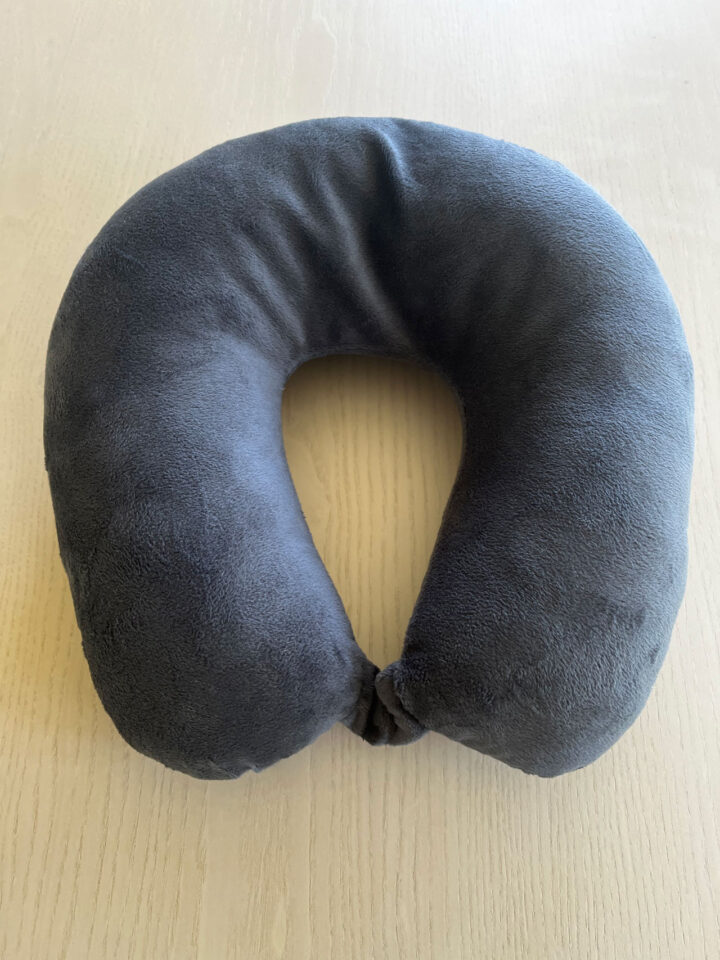
My family planned a trip to California, a 5 hour red-eye flight. This flight would be the perfect use-case. I knew that they’d charge me an arm and a leg for one at the airport, so I did some searching online prior to my trip. I read through reviews and it seemed as though most people had a good experience with airplane pillows. The negative reviews demonstrated reasonable and consistent complaints, so it was obviously not a slam-dunk. I picked the best airplane pillow I could find (“best?” It seems as though 90% of the airplane pillows available are nearly identical, so my thorough shopping efforts were largely in vain).
Pro tip: It turns out that the TSA doesn’t GAF about your little airplane pillow. Also, most airlines don’t count them as an individual carry on, so wrap as many as you want around your neck!
The day of my flight arrived. I wrapped the pillow around my neck and sheepishly proceeded to my gate.
My daughter made non-stop jokes about my appearance. “You expecting vampires on the plane?” She wouldn’t be laughing when she saw me sleeping soundly, head cradled in the magic airplane pillow!
We boarded the plane. I sat in my seat and quickly realized that the pillow was forcing my head forward, away from the seat back. My seat was completely upright still, as we hadn’t gotten off the ground. I removed the pillow from my neck and waited patiently with the it in my lap while the plane ascended into the night air.
DING. The seatbelt indicator lights dimmed. I quickly reclined my seat as far as it would go.
Normally, I’m not one to do a full recline. Yes, the seats are designed to do that, but it drives me crazy when the seat in front of protrudes into my precious space. I try to be a conscientious traveller. Fortunately, today my unsuspecting daughter was behind me. After suffering her abuse at the terminal, it seemed appropriate to push back as far as I could go.
With my seat now fully reclined, I placed my airplane will around my neck and prepared to relax.
It was immediately obvious that it wasn’t going to work.
The airplane pillow still pushed my neck and head forward in an uncomfortable bend. “How can anyone think this is comfortable?”
I tried to push the filling from the back edge to the two sides to allow more room for my head to lean backwards. Nope.
Fortunately this pillow had a zippered opening, which allowed me to remove some of the filling. That’s a unique feature that most airplane pillows don’t have. I opened it up and was surprised to see what appeared to be brown wool. Weird. (according to the product description, it’s actually a polyester microfiber)
I stowed the extra pillow filling in my seat pocket and tried again.
Better. Now the airplane pillow allowed enough room for my head to rest all the way back in my seat. I tried to relax. It still didn’t work for me. The pillow simply wasn’t thick enough on the sides to support my head. My cheek compressed the pillow filling, causing my neck to bend uncomfortably.
Resigned, I handed it to my daughter who was happy to give the airplane pillow a go in the dark cabin where aesthetics are of secondary concern. She too conceded that it wasn’t suitable when used as intended. She put the pillow in my wife’s lap and laid her head on it. Now it looked comfortable. I sat awake and endured the long night nodding off with Netflix.
I won’t be using it again.
My airplane pillow wasn’t useful. In fact, it made my seat more uncomfortable. Despite the adjustment in the amount of filling, it only served to take up valuable space and get in the way.
I am 6’1” tall. Perhaps it’d work for some with shorter or thicker necks. However, my 5’5″ daughter didn’t care for it either so that’s probably wishful thinking. Also worth mentioning: I wasn’t fortunate enough to have a window seat, but I imagine that if you could lean against the fuselage/window, it could feasibly be considerably more comfortable.
To the credit of the folks designing and manufacturing these pillows, it’s no easy task to make these things work.
Given my experience, I’d assume that a smaller rectangular or cylindrical (bolster) pillow would be preferable for use on an airplane. That said, there are a few other really unique designs that approach the issue of support much differently than the traditional u-shaped pillows. I’m resigned to flying sans pillow for now, but I might have to try again with a different type soon!
EDIT 3/1/24
I recently came across a few helpful threads at reddit about travel pillows. While most comments confirm my experience, some people invested in unique products that seem to actually work. I’ve never tried it, but people really seem to like a product called the “Trtl Pillow.”
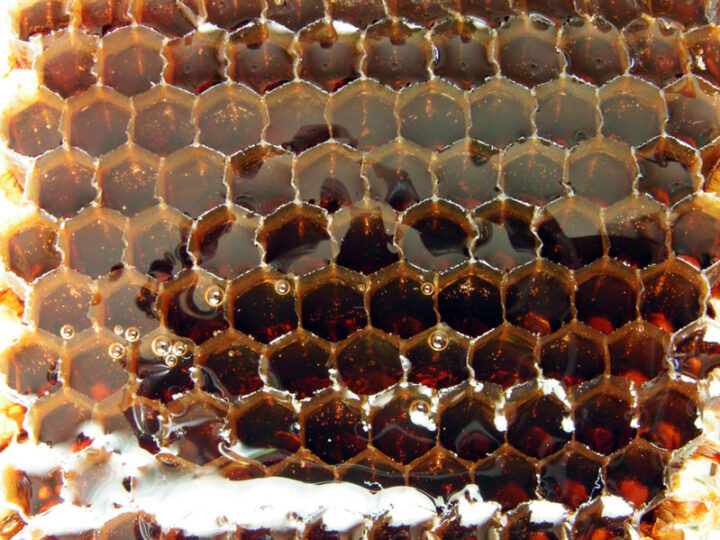
My wife recently asked me, “have you tried buckwheat honey before?” Nope. I’ve been living and breathing buckwheat pillows for many years and, oddly the opportunity to taste it had never come up. I was curious.

The internet’s flowery reviews call buckwheat honey “funky” and “like a barn.” That doesn’t really sound appetizing. Honey is supposed to be sweet and delicious… Undeterred, I ordered “pure buckwheat honey” from a company called Dutch Gold.
Buckwheat honey is very different from the yellow stuff in the plastic bear container.
Apparently the lighter a honey’s color, the milder the flavor. The typical yellow honey most of us are familiar with is filtered at high temperatures to remove things like pollen and beeswax. As a result, their flavors are much more mild.
Buckwheat honey’s dark color is a result of the polyphenols it contains . Polyphenols are type of micronutrient that naturally occurs in plants. Foods and beverages rich in polyphenol compounds typically are associated with bitterness.
When my package arrived, I pulled it out of the box and showed my kids.
It didn’t look like the traditional honey we’re used to. Buckwheat honey is quite dark in color, a translucent brown. I’d guess it was molasses if it wasn’t labeled. Apparently it ranges in color from purple to black.
They were anxious to taste it.
“Yuck.” The reaction was the same from both. They’re never enthusiastic about new foods, so I shrugged and indulged.
The flavor is strong and… unexpected. Weird. “Funky,” yes. It not only looks like molasses, it also tastes reminiscent. It’s a little spicy, with malty overtones. It has an odd bitter characteristic that is quite distinctive. It’s also not as sweet as typical honey.
Where the buck does it come from?
Most honey is distinct from other types because of the nectar of the flowers used to produce it. The buckwheat plant produces long-lasting flowers that bloom into the fall. These flowers create a distinct nectar that honey bees love. As such, beekeepers often plant buckwheat around their beehives. The resulting honey is unique in both appearance and taste.
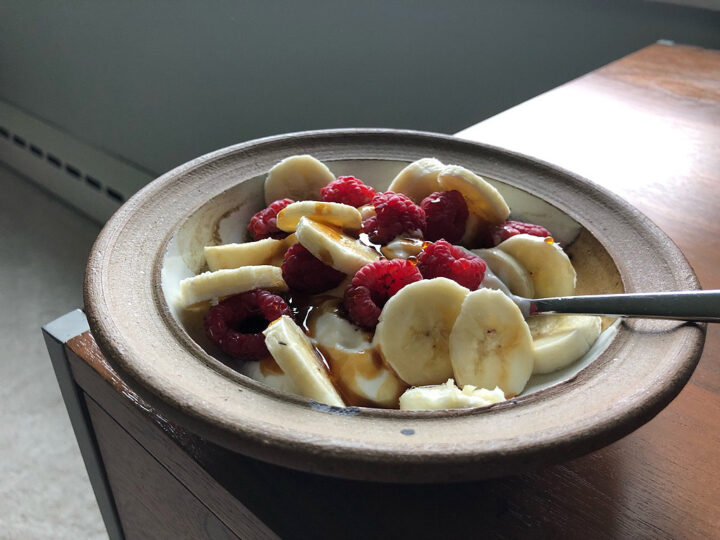
Buckwheat honey is an acquired taste.
Initially I thought it was a little too strange. But I’ve been having it with yogurt and fruit this week and it’s really grown on me. The flavor is surprisingly overpowering when sampled alone, but when it’s paired with other flavors, it’s really delicious. Halfway through the bottle, I’m a huge fan of buckwheat honey. My wife loves it too.
Is Buckwheat Honey Better for You Than Regular Honey?
Buckwheat honey is often considered more beneficial than regular honey due to its unique nutritional profile and higher antioxidant levels. Studies have shown that it contains a greater concentration of antioxidants compared to lighter, more common varieties of honey. Antioxidants are crucial for protecting the body from oxidative stress and reducing the risk of chronic diseases such as heart disease and cancer.
Furthermore, buckwheat honey has demonstrated stronger antimicrobial properties, making it more effective in soothing coughs and sore throats. Its rich, dark composition includes higher amounts of vitamins and minerals, such as iron, magnesium, and zinc, which contribute to its health benefits. Additionally, buckwheat honey’s low glycemic index means it has a more moderate effect on blood sugar levels, making it a better option for those monitoring their sugar intake.
Overall, while regular honey also offers various health benefits, the superior antioxidant content and enhanced therapeutic properties of buckwheat honey make it a more advantageous choice for those seeking additional health benefits from their sweeteners.
A couple good tips that can make your buckwheat honey more useful:
- Don’t use it in any recipe that calls for honey, because the flavor can be overpowering and it’s lacking the sweetness of traditional honey.
- Because it’s not a simple sweetener, it’s not quite as versatile as a traditional yellow honey. But it is great for when a little sweetness is required and extra flavor won’t get in the way of another. Thus it works well for things like marinades and bbq sauces.
